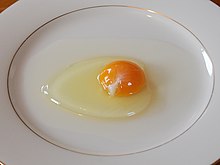アビジン
| Avidin | |||||||||
|---|---|---|---|---|---|---|---|---|---|
 core-streptavidin mutant d128a at pH 4.5 | |||||||||
| 識別子 | |||||||||
| 略号 | Avidin | ||||||||
| Pfam | PF01382 | ||||||||
| InterPro | IPR005468 | ||||||||
| PROSITE | PDOC00499 | ||||||||
| SCOP | 1slf | ||||||||
| SUPERFAMILY | 1slf | ||||||||
| |||||||||
| テンプレートを表示 | |||||||||

アビジン (Avidin) は、鳥類、爬虫類、両生類の卵管で産生される四量体型(英語版)ビオチン結合性タンパク質である。これらの動物の卵の白身に蓄積される。一部のバクテリアでは二量体型(英語版)のアビジンファミリーも存在する[1]。鶏卵の白身では、アビジンは全タンパク質の約0.05%を占める(卵1個当たり約180 μg)[2]。アビジンは4個の同じサブユニットを含み(ホモ四量体)、それぞれのサブユニットがビオチン(ビタミンB7、ビタミンH)を高い親和性と特異性で結合できる。アビジンとビオチンの解離定数Kdはおよそ10−15 Mと測定されており、既知の非共有結合性結合の中で最も強いものの一つである[3]。
四量体形では、アビジンの大きさは66–69 kDaと見積られている[4]。分子量の10%は、4から5残基のマンノースと3残基のN-アセチルグルコサミンから成る糖鎖によるものである[5]。アビジンの炭水化物部分は少なくとも3種の特徴的なオリゴ糖構造を含む[6]。それぞれの構造と成分は似ている。
調理によってアビジンのビオチン親和性は破壊されるため、機能を持つアビジンは生卵でのみ見られる。卵中のアビジンの自然な機能は分かっていないが、(細菌の成長を助けるビオチンに結合する)細菌成長阻害因子として卵管中で作られていると想定されている。この仮説の証拠として、アビジンと等しいビオチン親和性と非常によく似た結合部位を持つストレプトアビジンがストレプトマイセス属細菌のある株によって作られており、抗生物質のようにして競合する細菌の成長を阻害する働きをしていると考えられている[7]。
アビジンの非グリコシル化形が市販の製品に含まれている。しかしながら、非グリコシル化形が天然に存在するのか、あるいは製造工程の産物なのかは最終的な答えが出ていない[8]。
アビジンの発見

アビジンはエズモンド・エマーソン・スネル(英語版)によって最初に単離された。発見への道は、鶏に生卵白の食事を与えると、食事中にビオチンが存在するにもかかわらず、このビタミンが不足するという観察から始まった[9]。この観察から、卵白の成分がビオチンを捕捉していると結論付けられた[9]。スネルはこれを酵母試験を用いてin vitroで検証した[10]。スネルは後にビオチン結合を担う卵白の成分を単離し、パウル・ジエルジー(英語版)と協力して単離した卵タンパク質がビオチン欠乏症の原因であることを証明した[11]。その時点でこのタンパク質は研究に参加したテキサス大学の研究者らによって暫定的にavidalbumin(貪欲なアルブミンの意)と命名されていた[11]。タンパク質の名称は後にビオチンに対する親和性に基づいて「avidin」(avid + biotin)に改名された[12]。
ビオチンとの関係
アビジンのビオチンに対する親和性は非常に高く、ビオチンの腸管からの吸収を阻害するため、動物実験では生卵白の大量投与でビオチン不足とすることができる。
ビオチンは腸内細菌によって作られることもあって、かつてはヒトではビオチン不足に陥ることはないと考えられていた。しかし、抗生剤の服用などによって腸内細菌に影響を及ぼすこともあり、またビオチンの血中濃度が特別に低くもない患者にビオチン不足と思われる症状がみられるとき、ビオチンの大量投与で症状が緩和されたり治癒した場合もある。このことから、アビジンに関係なくビオチンの利用率には大きな個体差があるという説も出ている。
応用
ビオチンとアビジンの親和力は通常の抗原抗体反応の100万倍以上も強く、ほとんど不可逆的な結合を形成するため、免疫や細胞膜の研究用試薬、あるいはがんなどの検査用試薬、さらにはモノクローナル抗体と制がん剤を結びつけてがん細胞のみを直撃するミサイル療法製剤への適用などへの応用がある。
類似のタンパク質には、ストレプトマイセスの1種から得られるストレプトアビジンがあり、これも研究用試薬として用いられている。
改良形
塩基性の糖タンパク質であるため、アビジンは一部の応用において非特異的結合を示す。修飾アルギニンを含む脱グリコシル化アビジンであるニュートラアビジン(英語版)は、より中性の等電点(pI)を示し、非特異的結合の問題が生じた時には天然アビジンの代替物として利用可能である。脱グリコシル化された天然型アビジンはシグマ アルドリッチ(Extravidin)、サーモフィッシャー・サイエンティフィック(NeutrAvidin)、インビトロジェン(NeutrAvidin)、e-Proteins(NeutraLite)から販売されている。
アビジン-ビオチン結合の強度を考えると、アビジン-ビオチン複合体の解離はタンパク質変性を起こすほどの厳しい条件を必要とする。アビジン-ビオチン複合体の不可逆的性質は、アフィニティークロマトグラフィーにおけるアビジンの応用を制限する(捕捉されたリガンドは後で放出されるのが望ましい)。研究者らはアビジンの結合部位のチロシン残基をニトロ化あるいはヨウ素化することで可逆的な結合特性を持つアビジンを開発した[13]。この改良アビジンはpH 4で強いビオチン結合特性を示し、pH 10以上でビオチンを放す[13]。ビオチンに対する親和性が低下した単量体アビジンも多くの市販のアフィニティー樹脂で使用されている。単量体型アビジンは、固定化された天然アビジンを尿素あるいはグアニジン塩酸塩(6-8 M)で処理することで作られ、より低い解離定数(KD ≈ 10-7M)を示す[14]。これによって、より穏和な非変性条件で、より低濃度のビオチンあるいはより穏和なpH条件を用いてアビジンマトリックスからの溶出が可能になる。架橋を伴わない単一の高親和性ビオチン結合部位としては、ストレプトアビジンを使うことができる[15]。
脚注
- ^ Nurminen et al. 2007
- ^ “7 Avidinbased nanoparticles for drug delivery”. Applications of Nanocomposite Materials in Drug Delivery. Woodhead Publishing. (2018). p. 163. ISBN 978-0-12-813758-1. OCLC 1041152766. "Avidin makes up approximately 180 g/egg protein (approximately 0.05% of total protein)."
- ^ Green 1963
- ^ Korpela 1984
- ^ Green 1975
- ^ Bruch & White 1982
- ^ Hendrickson et al. 1989
- ^ Hiller et al. 1987
- ^ a b Eakin, McKinley & Williams 1940
- ^ Snell, Eakin & Williams 1940
- ^ a b Gyorgy 1941
- ^ Kresge, Simoni & Hill 2004
- ^ a b Morag, Bayer & Wilchek 1996
- ^ Kohanski & Lane 1990
- ^ Howarth (2006). “A monovalent streptavidin with a single femtomolar biotin binding site”. Nat. Methods 3 (4): 267-273. doi:10.1038/nmeth861. PMC 2576293. PMID 16554831. https://www.ncbi.nlm.nih.gov/pmc/articles/PMC2576293/.
参考文献
- Angerer, Lynne; Davidson, Norman; Murphy, William; Lynch, Dennis; Attardi, Giuseppe (1976). “An electron microscope study of the relative positions of the 4S and ribosomal RNA genes in HeLa cell mitochondrial DNA”. Cell 9 (1): 81–90. doi:10.1016/0092-8674(76)90054-4. PMID 975242.
- Büller, Harry; Gallus, Alex; Pillion, Gerard; Prins, Martin; Raskob, Gary (2012). “Enoxaparin followed by once-weekly idrabiotaparinux versus enoxaparin plus warfarin for patients with acute symptomatic pulmonary embolism: a randomised, double-blind, double-dummy, non-inferiority trial”. Lancet 379 (9811): 123–129. doi:10.1016/S0140-6736(11)61505-5. PMID 22130488.
- Bayer, Edward A.; Zalis, Mariano G.; Wilchek, Meir (1985). “3-(N-maleimido-propionyl) biocytin: A versatile thiol-specific biotinylating reagent”. Analytical Biochemistry 149 (2): 529–36. doi:10.1016/0003-2697(85)90609-8. PMID 3935007.
- Bayer, E. A.; Skutelsky, E.; Wynne, D.; Wilchek, M. (1976). “Preparation of ferritin-avidin conjugates by reductive alkylation for use in electron microscopic cytochemistry”. Journal of Histochemistry & Cytochemistry 24 (8): 933–9. doi:10.1177/24.8.182877. PMID 182877.
- Bruch, Richard C.; White, Harold B. (1982). “Compositional and structural heterogeneity of avidin glycopeptides”. Biochemistry 21 (21): 5334–41. doi:10.1021/bi00264a033. PMID 6816268.
- Durance, T. D. (1991). “Residual Avid in Activity in Cooked Egg White Assayed with Improved Sensitivity”. Journal of Food Science 56 (3): 707–9. doi:10.1111/j.1365-2621.1991.tb05361.x.
- Durance, T.D.; Wong, N.S. (1992). “Kinetics of thermal inactivation of avidin”. Food Research International 25 (2): 89–92. doi:10.1016/0963-9969(92)90148-X.
- Eakin, R. E.; McKinley, W. A.; Williams, R. J. (1940). “Egg-White Injury in Chicks and Its Relationship to a Deficiency of Vitamin H (Biotin)”. Science 92 (2384): 224–5. Bibcode: 1940Sci....92..224E. doi:10.1126/science.92.2384.224. PMID 17743857.
- Green, NM (1963). “Avidin. 1. The Use of (14-C)Biotin for Kinetic Studies and for Assay”. The Biochemical Journal 89: 585–91. PMC 1202466. PMID 14101979. http://www.biochemj.org/bj/089/0585/0890585.pdf.
- Green, N. Michael (1975). “Avidin”. In Anfinsen, Christian B.; Edsall, John Tileston; Richards, Frederic Middlebrook. Advances in Protein Chemistry Volume. 29. pp. 85–133. doi:10.1016/S0065-3233(08)60411-8. ISBN 978-0-12-034229-7. https://books.google.com/books?id=sMgpDLCl2z8C&pg=PA85
- Gyorgy, P.; Rose, C. S.; Eakin, R. E.; Snell, E. E.; Williams, R. J. (1941). “Egg-White Injury As the Result of Nonabsorption or Inactivation of Biotin”. Science 93 (2420): 477–8. Bibcode: 1941Sci....93..477G. doi:10.1126/science.93.2420.477. PMID 17757050.
- Heggeness, Michael H.; Ash, John F. (1977). “Use of the avidin-biotin complex for the localization of actin and myosin with fluorescence microscopy”. The Journal of Cell Biology 73 (3): 783–8. doi:10.1083/jcb.73.3.783. PMC 2111432. PMID 326797. http://www.jcb.org/cgi/pmidlookup?view=long&pmid=326797.
- Nurminen, Kirsi P.; Helppolainen, Satu H.; Määttä, Juha A. E.; Halling, Katrin K.; Slotte, J. Peter; Huhtala, Tuulia; Liimatainen, Timo; Ylä-Herttuala, Seppo et al. (2007). “Rhizavidin from Rhizobium etli: The first natural dimer in the avidin protein family”. Biochemical Journal 405 (3): 397–405. doi:10.1042/BJ20070076. PMC 2267316. PMID 17447892. https://www.ncbi.nlm.nih.gov/pmc/articles/PMC2267316/.
- Hendrickson, Wayne A.; Pahler, Arno; Smith, Janet L.; Satow, Yoshinori; Merritt, Ethan A.; Phizackerley, R. Paul (1989). “Crystal Structure of Core Streptavidin Determined from Multiwavelength Anomalous Diffraction of Synchrotron Radiation”. Proceedings of the National Academy of Sciences 86 (7): 2190–4. Bibcode: 1989PNAS...86.2190H. doi:10.1073/pnas.86.7.2190. JSTOR 33443. PMC 286877. PMID 2928324. https://www.ncbi.nlm.nih.gov/pmc/articles/PMC286877/.
- Hiller, Y; Gershoni, JM; Bayer, EA; Wilchek, M (1987). “Biotin binding to avidin. Oligosaccharide side chain not required for ligand association”. The Biochemical Journal 248 (1): 167–71. PMC 1148514. PMID 3435435. https://www.ncbi.nlm.nih.gov/pmc/articles/PMC1148514/.
- Hofmann, Klaus; Kiso, Yoshiaki (1976). “An Approach to the Targeted Attachment of Peptides and Proteins to Solid Supports”. Proceedings of the National Academy of Sciences 73 (10): 3516–8. Bibcode: 1976PNAS...73.3516H. doi:10.1073/pnas.73.10.3516. JSTOR 66631. PMID 185617.
- Kohanski, Ronald A.; Daniel Lane, M. (1990). “Monovalent avidin affinity columns”. Avidin-Biotin Technology. Methods in Enzymology. 184. pp. 194–200. doi:10.1016/0076-6879(90)84274-K. ISBN 978-0-12-182085-5. PMID 2388570
- Korpela, J (1984). “Avidin, a high affinity biotin-binding protein, as a tool and subject of biological research”. Medical Biology 62 (1): 5–26. PMID 6379329.
- Kresge, Nicole; Simoni, Robert D.; Hill, Robert L. (2004). “The Discovery of Avidin by Esmond E. Snell”. The Journal of Biological Chemistry 279 (41): e5. http://www.jbc.org/content/279/41/e5.full.
- Morag, Ely; Bayer, Edward A.; Wilchek, Meir (1996). “Reversibility of biotin-binding by selective modification of tyrosine in avidin”. The Biochemical Journal 316 (1): 193–9. PMC 1217322. PMID 8645205. http://www.biochemj.org/bj/316/0193/bj3160193.htm.
- Pritchard, Alan B.; McCormick, Donald B.; Wright, Lemuel D. (1966). “Optical rotatory dispersion studies of the heat denaturation of avidin and the avidin-biotin complex”. Biochemical and Biophysical Research Communications 25 (5): 524–8. doi:10.1016/0006-291X(66)90623-1.
- Snell, Esmond E.; Eakin, Robert E.; Williams, Roger J. (1940). “A Quantitative Test for Biotin and Observations Regarding its Occurrence and Properties”. Journal of the American Chemical Society 62: 175–8. doi:10.1021/ja01858a052.
- Wilchek, Meir; Ben-Hur, Haya; Bayer, Edward A. (1986). “P-Diazobenzoyl biocytin — A new biotinylating reagent for the labeling of tyrosines and histidines in proteins”. Biochemical and Biophysical Research Communications 138 (2): 872–9. doi:10.1016/S0006-291X(86)80577-0. PMID 3741438.







